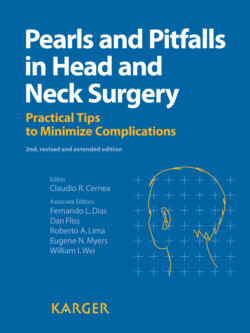Читать книгу Pearls and Pitfalls in Head and Neck Surgery - Группа авторов - Страница 21
На сайте Литреса книга снята с продажи.
ОглавлениеThyroid and Parathyroid Glands
Cernea CR, Dias FL, Fliss D, Lima RA, Myers EN, Wei WI (eds): Pearls and Pitfalls in Head and Neck Surgery. Basel, Karger, 2012, pp 30–31
DOI: 10.1159/000337472
1.15 Management of Well-Differentiated Carcinoma with Recurrent Laryngeal Nerve Invasion
James Paul O’Neill Jatin P. Shah
Department of Head and Neck Surgery, Memorial Sloan-Kettering Cancer Center, New York, N.Y., USA
P E A R L S
• In patients who have a preoperative vocal cord paralysis (VCP) secondary to tumor involvement of the recurrent laryngeal nerve (RLN), resection of the RLN should be performed.
• With functioning vocal cords, every effort should be made to preserve the RLN, not leaving gross tumor behind.
• When there is RLN invasion, the minimum operation should be a total thyroidectomy and postoperative radioiodine treatment.
• In cases of bilateral RLN invasion, at least one RLN should be preserved.
• When an invaded RLN is found, explore the contralateral side to ensure the integrity of the contralateral RLN prior to considering sacrifice of the involved RLN.
P I T F A L L
• Gross disease should never be left behind, as this leads to a high local failure rate, often with transformation to a more aggressive histology.
Introduction
Extrathyroid extension leading to invasion into surrounding anatomical structures occurs in 7-16% of cases of well-differentiated thyroid cancer (WDTC) [1]. While strap muscles are the most common structures involved by anterior extension of disease, the RLN is the next most commonly invaded structure, from posterior extrathyroid extension of disease. RLN invasion usually occurs at the cricothyroid junction by the primary tumor or in the tracheoesophageal groove by matted metastatic lymph nodes. Male sex, older age, nodal metastases, and aggressive histological subtypes of papillary carcinoma are associated with increased risk of RLN invasion [2–4].
Complete surgical resection of all gross disease is the cornerstone of therapy. Reliance on radioactive iodine (RAI) to treat gross residual disease is generally not effective. RAI may be used for microscopic residual disease as an adjunctive therapy for locoregional control.
Practical Tips
Preoperative indirect or flexible laryngoscopy is mandatory in all patients undergoing thyroid surgery. RLN invasion may or may not lead to VCP.
VCP warrants accurate assessment of the extent of tumor with a contrast-enhanced CT scan. In patients with extensive primary tumors, laryngotracheoscopy should be performed at the start of their surgery to assess intraluminal extension in the larynx or trachea.
The presence of RLN invasion implies extrathyroidal spread of tumor, and upstages the tu-mor to T4a. In contrast to invasion of the larynx, trachea, or esophagus [3], this does not necessarily portend a poor prognosis [2].
WDTC with extrathyroid extension is best treated with complete resection of all gross disease and a total thyroidectomy.
Removal of all gross tumor reduces the risk of local failure, as long as postoperative treatment with RAI or external beam radiotherapy (EBRT) is employed for microscopic residual disease (EBRT should be used for non-RAI avid disease such as the tall cell variant of WDTC, or poorly differentiated carcinoma).
In patients with normal vocal cord function, every effort should be made to preserve the functioning RLN, as long as all gross disease is removed [5–7].
Prior to sacrificing a functioning but invaded nerve, the integrity of the contralateral RLN should be ensured. The surgeon should endeavor to preserve the nerve on at least one side, if feasible. The immediate effect of bilateral RLN sacrifice or injury is stridor, which usually necessitates reintubation and subsequent tracheostomy or laser cordectomy for a safe airway.
Symptoms of unilateral VCP after thyroidectomy, where the nerve has been preserved (breathy voice and/or aspiration of thin liquids), are variable and may initially fluctuate. As most patients will experience spontaneous improvement, surgical medialization should be delayed for several months.
In the setting of iatrogenic damage to the RLN, immediate reconstruction by either direct repair or cable grafting has been advocated by some [8]. Others have advocated anastomoses between the descendens hypoglossi and the recurrent nerve when direct suture is not possible [9]. Despite not leading to any return in vocal cord movement, nerve repair may improve voice by preventing muscle atrophy [10].
Conclusion
The management of the RLN invaded by WDTC is an important issue. As a general rule, a paralyzed nerve, if grossly involved by tumor, should be resected, whereas every effort should be made to preserve a functioning nerve while achieving gross total resection of tumor.
References
1 McConahey WM, Hay ID, Woolner LB, et al: Papillary thyroid cancer treated at the Mayo Clinic, 1946 through 1970: initial manifestations, pathologic findings, therapy, and outcome. Mayo Clin Proc 1986;61:978–996.
2 McCaffrey TV, Bergstralh EJ, Hay ID: Locally invasive papillary thyroid carcinoma: 1940-1990. Head Neck 1994;16:165–172.
3 Shaha A: Implications of prognostic factors and risk groups in the management of differentiated thyroid cancer. Laryngoscope 2004;114:393–402.
4 Kebebew E, Clark OH: Locally advanced differentiated thyroid cancer. Surg Oncol 2003;12:91–99.
5 Chan WF, Lo CY, Lam KY, Wan KY: Recurrent laryngeal nerve palsy in well-differentiated thyroid carcinoma: clinicopathological features and outcome study. World J Surg 2004;28:1093–1098.
6 Nishida T, Nakao K, Hamaji M, Kamiike W, Kurozumi K, Matsuda H: Preservation of recurrent laryngeal nerve invaded by differentiated thyroid cancer. Ann Surg 1997;226:85–91.
7 Falk SA, McCaffrey TV: Management of the recurrent laryngeal nerve in suspected and proven thyroid cancer. Otolaryngol Head Neck Surg 1995;113:42–48.
8 Yumoto E, Sanuki T, Kumai Y: Immediate recurrent laryngeal nerve reconstruction and vocal outcome. Laryngoscope 2006;116:1657–1661.
9 Crumley RL, Izdebski K: Voice quality following laryngeal reinnervation by ansa hypoglossi transfer. Laryngoscope 1986;96:611–616.
10 Chou FF, Su CY, Jeng SF, Hsu KL, Lu KY: Neurorrhaphy of the recurrent laryngeal nerve. J Am Coll Surg 2003;197:52–57.
Jatin P. Shah, MD, PhD, FACS
1275 York Avenue
New York, NY 10065 (USA)
E-Mail shahj@MSKCC.ORG
